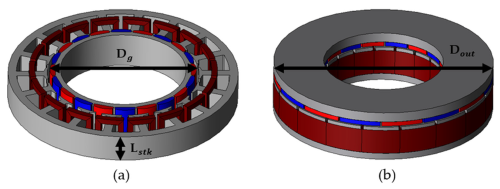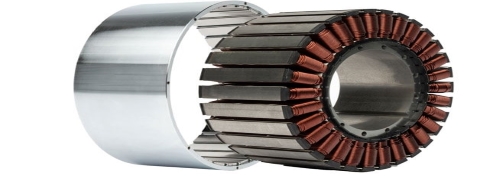Axial Flux Motor vs. Radial Flux Motor
Introduction
Axial flux and radial flux motors are two common motor types with distinct designs and characteristics. Each has advantages that make it suitable for different applications, from automotive to industrial uses. Here’s an in-depth comparison of their construction, performance, and ideal use cases.
1. Design and Construction
– Axial Flux Motor: In an axial flux motor, the magnetic flux travels parallel to the motor’s axis. The motor’s rotors and stators are placed side-by-side, creating a pancake-like structure. The magnetic field flows axially through the motor, allowing the rotors to be positioned close to each other, which results in a compact and flat design.
 [1]
[1]
– Radial Flux Motor: In a radial flux motor, the magnetic flux travels perpendicular to the axis. The stator and rotor are arranged in a cylindrical shape, with the magnetic flux radiating outwards from the motor’s center. This design is traditional in most electric motors and has a longer, more cylindrical form.
Further reading: An Overview of Axial Flux Motor & Axial Flux Motor Magnet
2. Efficiency and Power Density
– Axial Flux Motor: Axial flux motors tend to have a higher power density and efficiency due to their compact design and shorter magnetic path, which reduces energy losses. This makes them ideal for applications where space is limited, and efficiency is critical, such as in electric vehicles (EVs) and aerospace applications.

– Radial Flux Motor: While radial flux motors are highly efficient, they generally have lower power density compared to axial flux motors. The longer magnetic path and traditional cylindrical design make them less efficient in terms of space but provide reliable power output for many applications.
3. Cooling and Thermal Management
– Axial Flux Motor: The flat structure of axial flux motors can make thermal management challenging, as heat tends to accumulate in the middle. However, with effective cooling systems, they can maintain optimal performance. Advanced designs use liquid cooling or integrate airflow channels to help dissipate heat.
– Radial Flux Motor: Radial flux motors typically have better natural cooling due to their cylindrical design, which allows heat to disperse more evenly along the motor’s length. This makes them simpler to cool, often just requiring airflow or standard liquid cooling methods, which can be an advantage in high-power applications.
4. Torque Characteristics
– Axial Flux Motor: Axial flux motors generally produce high torque at low speeds due to their shorter magnetic path and large diameter, which allows for greater leverage. This makes them suitable for applications that require a high torque-to-weight ratio, such as in EVs or small electric aircraft.
– Radial Flux Motor: Radial flux motors typically produce moderate torque but can handle higher speeds more easily than axial flux motors. They are a good fit for applications requiring consistent power over a wide speed range, such as industrial machinery.
5. Manufacturing Complexity and Cost
– Axial Flux Motor: Axial flux motors are often more complex to manufacture due to their unique design and materials required to optimize the magnetic path. This can make them more expensive than radial flux motors, particularly for high-power or custom applications.
– Radial Flux Motor: Radial flux motors have been the standard for many years and are generally simpler and less expensive to produce. Their established design means that they are widely available and more affordable in various sizes and configurations.
6. Applications
– Axial Flux Motor: Due to their high power density, axial flux motors are favored in space-constrained applications that require high torque, such as electric vehicles, aerospace systems, robotics, and high-performance motor applications.
– Radial Flux Motor: Radial flux motors are widely used in industrial applications, pumps, fans, and general-purpose motors where size constraints are less critical, and consistent performance across a range of speeds is necessary.
| Feature | Axial
Flux Motor |
Radial
Flux Motor |
| Design | Flat,
pancake-like structure, axial flux |
Cylindrical
structure, radial flux |
| Power Density | High | Moderate |
| Efficiency | High (due to
shorter magnetic path) |
Moderate
to high, reliable |
| Cooling | Complex
(requires advanced cooling) |
Simpler
(natural or standard liquid cooling) |
| Torque | High torque
at low speeds |
Moderate torque,
better at high speeds |
| Manufacturing Cost | Higher (more
complex design) |
Lower
(standard, established design) |
| Applications | EVs, aerospace,
robotics, high-torque needs |
Industrial,
pumps, fans, wide-speed range |
Conclusion
Axial and radial flux motors serve different roles. Axial flux motors, with their high power density and torque, are excellent for applications where space, weight, and efficiency are critical, such as in EVs and aerospace. Radial flux motors, with their simpler cooling requirements and established reliability, are better suited for industrial applications that require consistent performance and lower manufacturing costs.
Choosing the right motor type depends on specific application needs, including space constraints, torque requirements, and budget. For more magnet products and magnet assemblies, please visit Stanford Magnets.
Reference:
[1] Hong, Min-Ki & Pyo, Hyun-Jo & Song, Si-Woo & Jung, Dong-Hoon & Kim, Won-ho. (2023). A Study on the Improvement of Power Density of Axial Flux Motors for Collaborative Robot Joints through Same-Direction Skew. Machines. 11. 591. 10.3390/machines11060591.